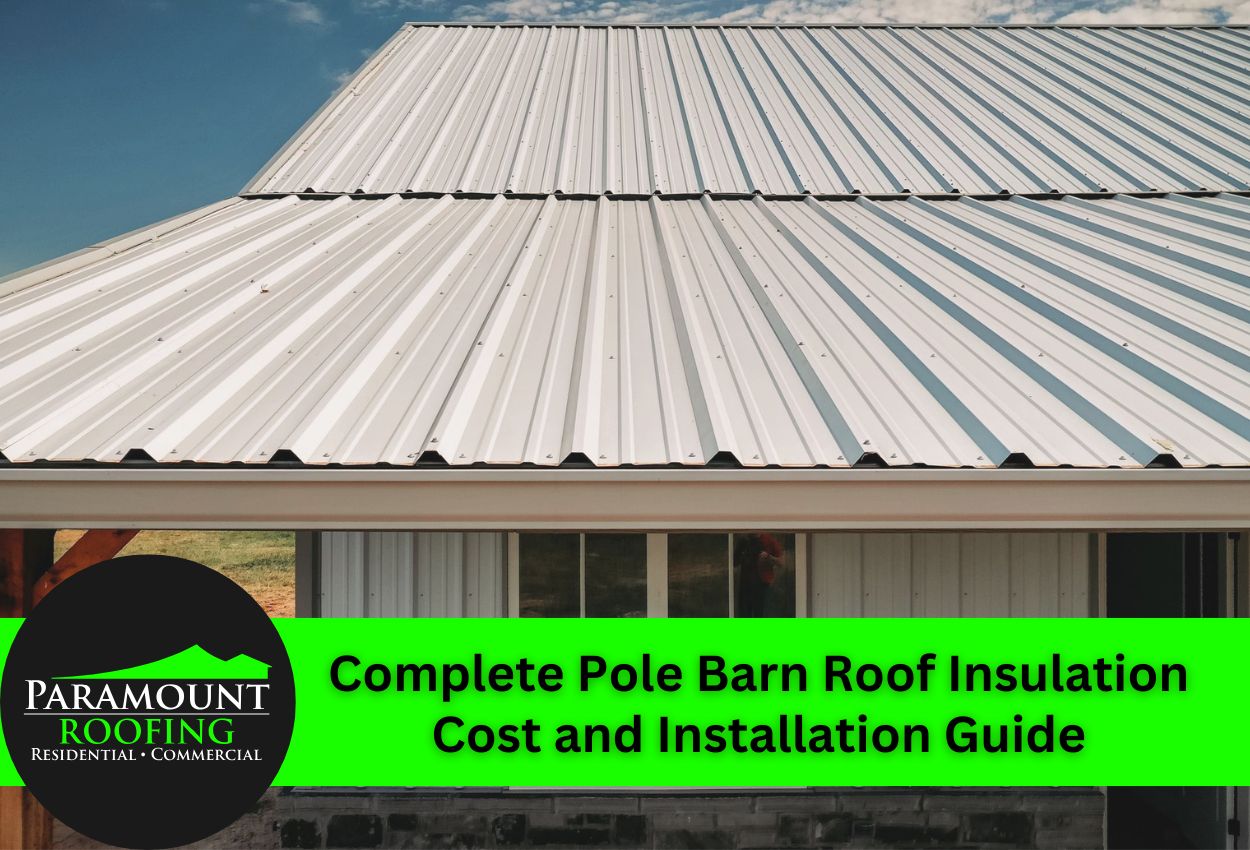Proper insulation for pole barn roofs stands as one of the most critical yet overlooked aspects of post-frame construction. Without adequate insulation, these versatile structures become unbearably hot in Michigan summers and frigid during the harsh winters. Beyond comfort, insulation directly impacts energy bills, building longevity, and interior functionality.
Pole barn roof insulation offers significant benefits, including temperature regulation, moisture control, condensation prevention, and noise reduction. For agricultural buildings, workshops, or residential pole barns, the right insulation transforms these spaces from seasonal-use structures to year-round functional environments.
Selecting the appropriate insulation involves understanding R-values specific to metal buildings, comparing materials like spray foam, rigid board, and reflective barriers, and evaluating installation methods suited to post-frame construction. DIY pole barn insulation has become increasingly popular among property owners looking to maximize energy efficiency while managing project expenses.
The insulation requirements for pole barns in Detroit and surrounding Michigan areas differ significantly from warmer regions, which means you need to consider material performance in changing temperatures. Energy-efficient insulation options not only reduce utility costs but also extend the functional lifespan of agricultural and commercial post-frame buildings.
Understanding Pole Barn Roof Insulation Options & R-Values
When selecting the right insulation for your pole barn roof, it’s essential to understand the characteristics of different materials. The R-value, which measures thermal resistance, is especially important when dealing with the temperature extremes common in the Detroit area.
Spray foam insulation offers superior performance with R-values between R6 and R7 per inch, creating an airtight seal that prevents heat transfer and moisture infiltration. While initially more expensive, its excellent moisture resistance makes it ideal for Michigan’s humid summers and snowy winters.
Rigid foam board provides consistent R-values of R4 to R6.5 per inch and creates a thermal break that prevents heat conduction through metal roofs. This option works well in post-frame construction where direct attachment to roof purlins is possible.
Fiberglass batts remain popular for DIY pole barn insulation projects, offering R3 to R4 per inch at a lower cost. However, vapor barriers must be installed to prevent moisture issues.
Reflective radiant barriers have lower R-values but excel at reflecting summer heat, making them effective supplemental insulation for pole barns. Many professional metal building contractors recommend combining reflective barriers with traditional insulation for optimal energy efficiency in pole barns throughout Michigan.
Breaking Down the Costs: What to Budget for Your Pole Barn Insulation Project
There are multiple factors that contribute to the final cost of your pole barn insulation installation. Material costs vary significantly based on the insulation type you select, with spray foam typically having higher prices than fiberglass or reflective barriers. The required R-value for Michigan’s climate zone significantly affects your budget — higher R-values mean better insulation but also increased material quantities.
Square footage calculation is crucial when estimating materials. A typical 30-by-40 pole barn roof requires approximately 1,200 square feet of insulation, but waste factors and coverage gaps must be accounted for. Metal building specifications like purlin spacing and roof pitch can also affect material quantities and installation complexity.
Labor represents a substantial portion of professional insulation installation costs. Experienced roofers in the Detroit area can complete installations efficiently, with proper equipment for safely working at heights and handling specialized materials. While DIY installation can reduce immediate expenses, it requires specialized tools like lifts, spray equipment, or proper cutting implements, depending on your chosen material.
Many property owners find that energy efficiency improvements pay off over time. Agricultural buildings with proper roof insulation often see heating and cooling cost reductions of 20% to 30%, creating significant long-term savings that offset initial investment. Properly insulated post-frame structures also experience less condensation damage, extending the building’s useful life.
Step-by-Step Pole Barn Roof Insulation Installation Guide
When installing insulation in your pole barn, the project needs thorough planning, especially in Michigan, where temperature extremes put extra stress on buildings. Before beginning any installation, safety should be your primary concern. Always use fall protection equipment, ensure sturdy scaffolding or lifts, and never work alone on elevated projects.
For the installation, you will need tools including a tape measure, utility knife, staple gun, protective gear, and sealing materials. Accurate measurements are critical. Measure between trusses and purlins at multiple points since pole barns often have slight variations in spacing that can affect material requirements.
When installing fiberglass batts, position them with the vapor barrier facing the interior space. For spray foam applications, surfaces must be clean and dry before application for proper adhesion. With reflective barriers, maintain the recommended air gap for maximum effectiveness in reducing radiant heat transfer.
Pay special attention to sealing around trusses, penetrations, and transitions to prevent thermal bridging and air leakage. Many post-frame buildings in the Detroit area develop condensation problems due to improperly sealed vapor barriers. Ensure continuous coverage without gaps, as even small openings can significantly reduce insulation performance.
Professional roofing contractors familiar with pole barns can ensure your insulation meets both energy efficiency goals and building code requirements specific to Michigan’s climate.
Pole Barn Insulation: DIY vs. Professional
Deciding between DIY and professional installation for your pole barn roof insulation requires thinking about a few different things. For simpler projects with accessible roof designs and basic insulation materials like fiberglass batts, DIY installation can be feasible for those with construction experience. Successful DIY projects typically involve single-story structures with standard purlin spacing and straightforward roof geometry. However, be realistic about your skill level — insulation installation requires precision to avoid gaps that compromise energy efficiency.
DIY installations require a significant time investment. A typical 30-by-40-foot pole barn roof might require 2 to 3 full weekends for an inexperienced installer, plus additional time for research and material procurement. You’ll also need specialized equipment — ladders, safety harnesses, protective gear, and material handling tools — that aren’t insignificant expenses if you don’t already own them.
Professional installation offers countless advantages for agricultural and workshop buildings in the Detroit area. Experienced contractors complete installations in a fraction of the time with superior results, particularly with technical materials like spray foam that require specialized equipment and expertise. Professionals also ensure proper vapor barrier installation, which is critical in Michigan’s humid summers and cold winters, and can identify potential condensation issues before they cause damage.
Professional installation often includes warranties covering both materials and workmanship, providing protection for your investment. Additionally, contractors familiar with local building codes ensure your pole barn meets energy efficiency requirements specific to our region, potentially qualifying your project for energy incentive programs.
Maximizing Energy Efficiency With Strategic Insulation Approaches
Effective pole barn roof insulation in Michigan requires more than just selecting the right materials — it needs strategic approaches to manage moisture and maximize thermal performance. In our humid climate, condensation management is critical to prevent structural damage and insulation failure. Proper ventilation systems, including ridge vents and soffit intakes, create airflow that removes moisture before it can accumulate on metal surfaces. Without this balance, even the highest R-value insulation can become compromised.
Creating effective thermal breaks is another popular strategy for post-frame buildings. Metal conducts heat rapidly, making traditional insulation less effective where metal fasteners penetrate the building envelope. Advanced techniques include using thermal spacers between purlins and the metal roof, installing double-layer insulation systems with offsetting seams, and installing specialized fastening systems that minimize thermal bridging.
Combining insulation types often delivers superior performance in Michigan’s variable climate. A reflective radiant barrier paired with spray foam creates a system that both reflects summer heat and prevents winter heat loss. This hybrid approach helps agricultural buildings maintain consistent interior conditions while minimizing energy costs throughout Detroit’s seasonal extremes.
Preventing air leakage requires careful attention to sealing techniques around penetrations, transitions, and joints. Professional installers use specialized tapes, gaskets, and sealants designed specifically for metal buildings. These seemingly minor details often make the difference between an energy-efficient pole barn and one that wastes energy.
Maintenance, Longevity, & Return on Investment of Pole Barn Insulation
Correctly installed pole barn roof insulation delivers value beyond the initial installation, but only with maintenance over time. Regular inspection of your insulation system should become part of your building maintenance routine, especially after severe weather common to the Detroit area. Look for signs of water staining, sagging insulation, or visible gaps that might indicate moisture infiltration or physical damage. In agricultural buildings, be extra vigilant about rodent damage, which can quickly compromise even the best insulation systems.
Addressing small issues promptly prevents them from becoming big problems. If you notice condensation forming on metal surfaces during temperature swings, this often indicates insulation failure or inadequate vapor barrier protection. Michigan’s freeze-thaw cycles can be particularly harsh on pole barn roofing systems, making regular maintenance essential for preserving insulation performance.
The return on investment for quality pole barn insulation becomes clear when analyzing long-term benefits. Energy-efficient agricultural buildings typically see heating and cooling costs reduced by 20% to 30%, creating substantial savings over time. Post-frame buildings with proper roof insulation also maintain more consistent interior temperatures, reducing the strain on HVAC equipment and extending its operational life.
Other thyan energy savings, properly insulated metal buildings experience less condensation-related damage to structural components, electrical systems, and stored contents. This protection extends the useful life of your pole barn and helps maintain its value. For commercial and residential pole barns throughout Michigan, these benefits make quality roof insulation one of the most important investments in your building’s future.
Choose Paramount Roofing for Your Pole Barn Insulation Needs
Making sure your pole barn is sufficiently insulated is crucial for maintaining a cost-effective, energy-efficient, and durable structure, especially in Michigan. Paramount Roofing specializes in high-quality roofing solutions, including tailored insulation services that cater specifically to pole barns. Whether you’re considering DIY insulation or prefer professional installation, understanding your options and the associated costs is essential.
At Paramount Roofing, we provide comprehensive assessments to help you choose the best insulation material and method that fits your budget and meets your building’s requirements. Don’t let improper insulation techniques compromise your pole barn’s integrity and performance. Call us today at (586) 690-0227 to discuss your insulation needs and how we can help maximize your investment with reliable, effective solutions.
 Free Estimate
Free Estimate
 Request Service
Request Service Locations
Locations 
